

 |
Search the Site with

|
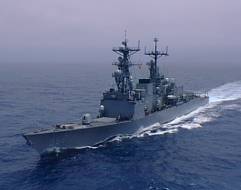 | 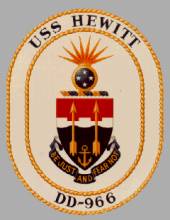 | 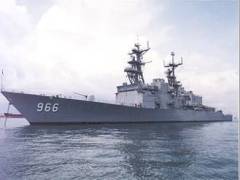 |
USS HEWITT was the fourth ship in the SPRUANCE - class and was last homeported in San Diego, Ca. On July 13, 2001, after 25 years of service, the HEWITT was decommissioned in San Diego, Ca. Stricken from the Navy list on June 5, 2002, the HEWITT was sold to Brownsville International Shipbreaking Corp., Tx., for scrapping on December 19, 2002.
| General Characteristics: | Keel Laid: July 23, 1973 |
| Christened: September 14, 1974 | |
| Commissioned: September 25, 1976 | |
| Decommissioned: July 13, 2001 | |
| Builder: Ingalls Shipbuilding, West Bank, Pascagoula, Miss. | |
| Propulsion system: four General Electric LM 2500 gas turbine engines | |
| Propellers: two | |
| Blades on each Propeller: five | |
| Length: 564,3 feet (172 meters) | |
| Beam: 55,1 feet (16.8 meters) | |
| Draft: 28,9 feet (8.8 meters) | |
| Displacement: approx. 9,200 tons full load | |
| Speed: 30+ knots | |
| Aircraft: two | |
| Armament: two | |
| Crew: approx. 340 |
Crew List:
This section contains the names of sailors who served aboard USS HEWITT. It is no official listing but contains the names of sailors who submitted their information.
USS HEWITT Cruise Books:
About the ship’s name, about Admiral H. Kent Hewitt:
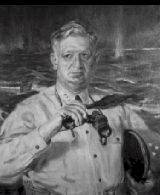 USS HEWITT was named for Admiral H. Kent Hewitt. Admiral Hewitt was born in Hackensack, New Jersey, on 11 February 1887 and graduated from the U.S. Naval Academy in 1906. Prior to his promotion to flag rank, Admiral Hewitt served aboard several battleships and destroyers, including USS MISSOURI (BB 11), USS CONNECTICUT (BB 18), USS FLUSSER (DD 20), USS FLORIDA (BB 30), and USS PENNSYLVANIA (BB 38). He commanded USS EAGLE, USS CUMMINGS (DD 44), USS LUDLOW (DD 112), Destroyer Division 12 and USS INDIANAPOLIS (CA 35). During the 1920s and 1930s, he was involved in naval gunnery and ordnance as Pacific Fleet Gunnery Officer and Inspector of Ordnance in charge of the Naval Ammunition Depot at Puget Sound, Washington, while sharpening his knowledge of shore bombardment so necessary in his later amphibious assaults.
USS HEWITT was named for Admiral H. Kent Hewitt. Admiral Hewitt was born in Hackensack, New Jersey, on 11 February 1887 and graduated from the U.S. Naval Academy in 1906. Prior to his promotion to flag rank, Admiral Hewitt served aboard several battleships and destroyers, including USS MISSOURI (BB 11), USS CONNECTICUT (BB 18), USS FLUSSER (DD 20), USS FLORIDA (BB 30), and USS PENNSYLVANIA (BB 38). He commanded USS EAGLE, USS CUMMINGS (DD 44), USS LUDLOW (DD 112), Destroyer Division 12 and USS INDIANAPOLIS (CA 35). During the 1920s and 1930s, he was involved in naval gunnery and ordnance as Pacific Fleet Gunnery Officer and Inspector of Ordnance in charge of the Naval Ammunition Depot at Puget Sound, Washington, while sharpening his knowledge of shore bombardment so necessary in his later amphibious assaults.
In April 1942, Admiral Hewitt took command of the amphibious forces in the Atlantic Fleet. He distinguished himself during landings in North Africa in late 1942. In July 1943, Admiral Hewitt's Eighth Fleet conducted the first Allied Amphibious landings of Europe in World War II. It was this amphibious assault on Sicily that landed General George Patton and his Third Armored Division that ultimately led to the surrender of Fascist Italy.
Admiral Hewitt retired in 1949 and passed away in 1972 in Orwell, Vermont.
History of USS HEWITT:
Keel laying for HEWITT took place 23 July 1973 at Ingalls Shipbuilding Division of Litton Industries in Pascagoula, MS. Mrs. Leroy Hewitt Taylor and Mrs. Gerald Hewitt Norton, Admiral Hewitt’s daughter’s christened HEWITT on 14 September 1974 at Ingalls Shipyard. HEWITT was commissioned on 25 September 1976.
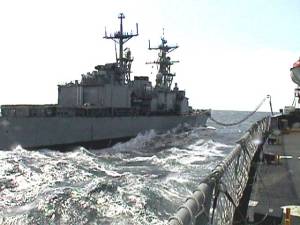 After an intensive period of initial training, HEWITT deployed to Western Pacific in September 1978 and was assigned to the SEVENTH Fleet. In addition to serving as a front line unit, HEWITT also acted as a good will ambassador with port visits to Australia, New Zealand, Fiji and Hong Kong. HEWITT returned to San Diego in April 1979. In preparation for her next deployment, HEWITT participated in a multinational Rim-of-the-Pacific (RIMPAC) battle group exercise in February and March 1980. She departed on her second overseas deployment on 15 May 1980. During that deployment, HEWITT and other members of Battle Group CHARLIE operated in the Indian Ocean to show U.S. resolve to protect free world access to Middle East petroleum resources, and to help obtain the release of 52 Americans held hostage in Iran. HEWITT earned the Navy Expeditionary for her contributions. During the latter part of the deployment, HEWITT also earned the Humanitarian Service Medal for rescuing a group of Vietnamese boat refugees adrift in the South China Sea. For her superior performance, HEWITT was awarded the Battle "E" as the most outstanding ship in Destroyer Squadron TWENTY-ONE from 1979 to 1980.
After an intensive period of initial training, HEWITT deployed to Western Pacific in September 1978 and was assigned to the SEVENTH Fleet. In addition to serving as a front line unit, HEWITT also acted as a good will ambassador with port visits to Australia, New Zealand, Fiji and Hong Kong. HEWITT returned to San Diego in April 1979. In preparation for her next deployment, HEWITT participated in a multinational Rim-of-the-Pacific (RIMPAC) battle group exercise in February and March 1980. She departed on her second overseas deployment on 15 May 1980. During that deployment, HEWITT and other members of Battle Group CHARLIE operated in the Indian Ocean to show U.S. resolve to protect free world access to Middle East petroleum resources, and to help obtain the release of 52 Americans held hostage in Iran. HEWITT earned the Navy Expeditionary for her contributions. During the latter part of the deployment, HEWITT also earned the Humanitarian Service Medal for rescuing a group of Vietnamese boat refugees adrift in the South China Sea. For her superior performance, HEWITT was awarded the Battle "E" as the most outstanding ship in Destroyer Squadron TWENTY-ONE from 1979 to 1980.
HEWITT entered the Long Beach Naval Shipyard in 19 May 1981 for its first regular overhaul. Extensive modifications were performed to improve survivability, and new combat systems capabilities were added to improve quick reaction to missile attacks. After a rigorous re-qualification and retraining period, HEWITT departed on 21 March 1983 for its third deployment. Highlights included a three aircraft carrier fleet exercise with USS MIDWAY, USS CORAL SEA and USS ENTERPRISE, and independent operations in the South China Sea.
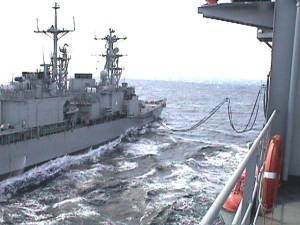 HEWITT departed on her fourth deployment on 18 October 1984. Once again a member of Battle Group CHARLIE, she spent seven highly successful months in the Western Pacific and Indian Oceans. In January 1985, HEWITT set a record at the Tabones Firing Range in the Philippines by earning the highest score ever recorded at the range for Naval Gunfire Support (NGFS) exercise. From February to April 1985, HEWITT operated in the North Arabian Sea and Gulf of Oman. For its achievements during the deployment, HEWITT received the Meritorious Unit Citation. HEWITT returned home to San Diego on 24 May 1985.
HEWITT departed on her fourth deployment on 18 October 1984. Once again a member of Battle Group CHARLIE, she spent seven highly successful months in the Western Pacific and Indian Oceans. In January 1985, HEWITT set a record at the Tabones Firing Range in the Philippines by earning the highest score ever recorded at the range for Naval Gunfire Support (NGFS) exercise. From February to April 1985, HEWITT operated in the North Arabian Sea and Gulf of Oman. For its achievements during the deployment, HEWITT received the Meritorious Unit Citation. HEWITT returned home to San Diego on 24 May 1985.
On 1 September 1985, HEWITT and other members of Destroyer Squadron THIRTY-ONE became the first Pacific Fleet Anti-Submarine Warfare Squadron. The squadron's basic mission was to locate and track submarines in the Eastern Pacific, to develop USW tactics and training, and to serve as a ready response force under Commander, THIRD Fleet. From September 1985 to April 1987, HEWITT and the other ships in Destroyer Squadron THIRTY-ONE set new standards of excellence in USW.
During HEWITT's second overhaul (May 1987 to November 1988) at National Steel and Shipbuilding Company Shipyard in San Diego, California, she underwent a modernization which included installation of the Vertical Launch System, the Tomahawk Missile System, the Close-In Weapons System (CIWS), LAMPS MK III, and the SQO-89 Sonar System. After a brief but extensive training and inspection cycle, HEWITT joined Destroyer Squadron TWENTY-ONE and once again deployed to the Arabian Gulf on 18 September 1989. HEWITT's fifth Western Pacific deployment ended on 16 March 1990. Five months later, HEWITT was underway to her new homeport at Yokosuka, Japan.
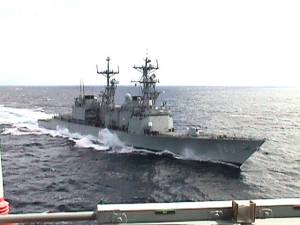 HEWITT joined Destroyer Squadron FIFTEEN on 25 August 1990. In Yokosuka, she operated with numerous multi-national forces, including the Japanese Maritime Self-Defense Force, and the South Korean, Bruinese, Greek, French, Spanish, Australian, Saudi Arabian, Russian, British, and Singaporean navies. HEWITT concluded an intensive six month deployment to the Arabian Gulf in April 1993. Her seventh deployment was highlighted by a Tomahawk strike against Iraq and combined operations with numerous navies, the Russian Destroyer ADMIRAL TRIBUTS. HEWITT also served as Maritime Action Group (MAG) Commander in October 1993, helping to develop the new MAG warfare concept. HEWITT was awarded the Meritorious Unit Commendation for the 1992 to 1993 Arabian Gulf deployment and the SEVENTH Fleet’s USW Excellence Award for 1993.
HEWITT joined Destroyer Squadron FIFTEEN on 25 August 1990. In Yokosuka, she operated with numerous multi-national forces, including the Japanese Maritime Self-Defense Force, and the South Korean, Bruinese, Greek, French, Spanish, Australian, Saudi Arabian, Russian, British, and Singaporean navies. HEWITT concluded an intensive six month deployment to the Arabian Gulf in April 1993. Her seventh deployment was highlighted by a Tomahawk strike against Iraq and combined operations with numerous navies, the Russian Destroyer ADMIRAL TRIBUTS. HEWITT also served as Maritime Action Group (MAG) Commander in October 1993, helping to develop the new MAG warfare concept. HEWITT was awarded the Meritorious Unit Commendation for the 1992 to 1993 Arabian Gulf deployment and the SEVENTH Fleet’s USW Excellence Award for 1993.
Following a brief maintenance availability in early 1994. HEWITT participated in RIMPAC ’94. Directly following the exercise, HEWITT conducted live missile firings near Barking Sands, Kauai, Hawaii which included a successful NATO Seasparrow engagement and the first fleet firing of the Penguin anti-ship missile with HSL 51 Det 6 on 25 June 1994. HEWITT again deployed to the Arabian Gulf on 05 September 1994 as a primary component of the multinational Middle East peace keeping unit, enforcing United Nations sanctions against Iraq. HEWITT returned to Yokosuka, Japan 10 January 1995 and received SEVENTH Fleet’s Surface Warfare Award for 1994.
On 17 March 1995, HEWITT entered the yards for an extended availability period which ended 05 September 1995. Afterwards, HEWITT participated in several multinational USW exercises and was awarded the Battle "E" for her performance in 1995.
On 03 June 1996, HEWITT deployed to the Arabian Gulf for Middle East Force deployment (MEF) 96-2. While supporting FIFTH Fleet operations, HEWITT participated in operation DESERT STRIKE and launched two Tomahawk missiles on 04 September 1996 against Iraq. HEWITT received a Meritorious Unit Commendation for her actions during the deployment and returned home to Yokosuka, Japan on 30 October 1996.
In March 1997, HEWITT conducted Battle Group exercises with USS INDEPENDENCE and in April COMDESRON FIFTEEN for SHAREM 120B conducted with the Republic of Korea Navy. In May HEWITT entered an availability and received the women at-sea modification to berth the first females permanently assigned to the ship. The first female Sailors reported on board in July. On 24 August 1997, HEWITT departed Yokosuka, Japan for a homeport change to San Diego, California. HEWITT joined Destroyer Squadron TWENTY-THREE on 29 August 1997 during her transit to San Diego.
On 27 January 1999, HEWITT deployed to the Arabian Gulf for Middle East Force Deployment (MEF) 99-1. In support of U.N. Sanctions against Iraq. HEWITT conducted Visit, Board, Search and Seizure of merchants in the area. HEWITT returned to San Diego on 26 July 1999 followed by a two month Selected Restricted Availability which ended 07 November 1999.
After operating in the U.S. 7th Fleet's area of responsibility - with port visits to Australia, Thailand, Singapore and Hong Kong -- before participating in Operation Southern Watch in the Arabian Gulf, USS HEWITT’s PACMEF 00-4 deployment was drawing to a close in May 2001. This marked the final cruise of the destroyer’s 24 years of service.
During the deployment, HEWITT conducted 35 days of maritime interception operations in the Arabian Gulf supporting U.N. sanctions against Iraq.
More than 115 crew members qualified as enlisted surface warfare specialists (ESWS), highlighted by each petty officer 1st class and above becoming ESWS qualified. This achievement earned the destroyer the silver ESWS pennant.
HEWITT was decommissioned on July 13, 2001, at 10:00am at Pier 7 Naval Station San Diego.
USS HEWITT Patch Gallery:
 | 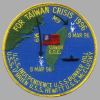 |
USS HEWITT Image Gallery:
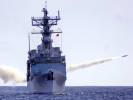 |  | 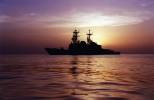 | 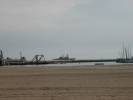 | 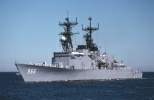 |
The photos below were taken by William Chiu and show USS HEWITT and USS VINCENNES at Hong Kong in December 1991.
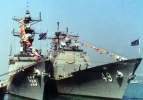 | 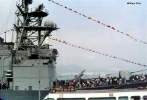 | 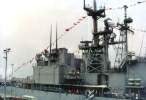 |  |
The photo below was taken by Peter Cole and shows the HEWITT in one of the drydocks in Yokosuka, Japan, in the mid-1990s.
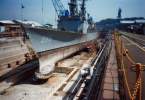 |
 Back to Destroyers list.
Back to Destroyers list.  Back to ships list.
Back to ships list.  Back to selection page.
Back to selection page.  Back to 1st page.
Back to 1st page.